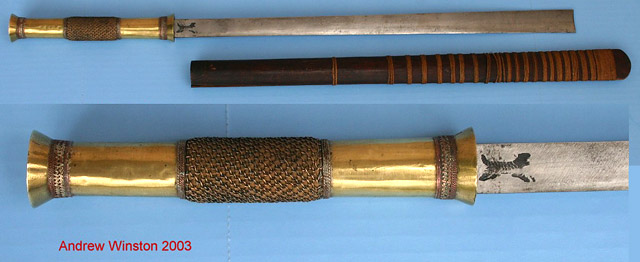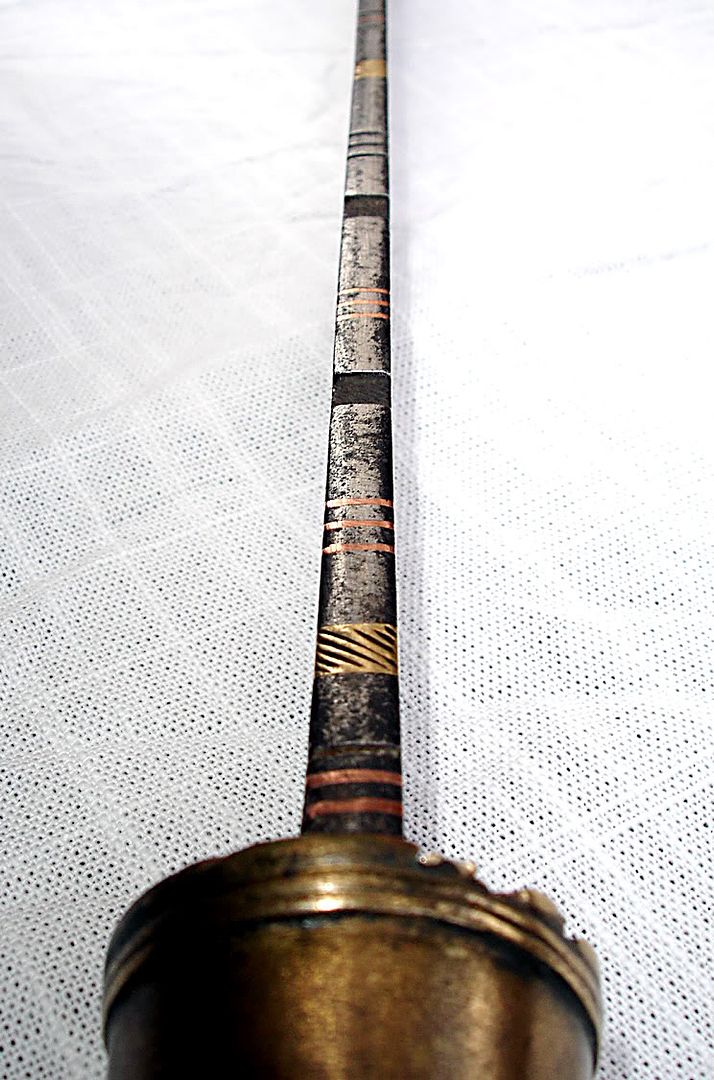
 |
|
|||||||
 |
|
|
Thread Tools | Search this Thread | Display Modes |
|
|
|
|
#1 |
|
Member
Join Date: Nov 2004
Location: USA
Posts: 1,725
|
|
|
|

|
|
|
#2 |
|
Member
Join Date: Nov 2004
Location: USA
Posts: 1,725
|
Here are some pix and old threads regarding some other markings for discussion:
http://www.vikingsword.com/ubb/Forum1/HTML/001540.html  http://www.vikingsword.com/vb/showth...ht=spine+marks   http://www.vikingsword.com/vb/showth...ht=spine+marks http://www.vikingsword.com/vb/showth...ht=spine+marks 
|
|
|

|
|
|
#3 | |
|
Arms Historian
Join Date: Dec 2004
Location: Route 66
Posts: 9,785
|
Quote:

|
|
|
|

|
|
|
#4 |
|
Arms Historian
Join Date: Dec 2004
Location: Route 66
Posts: 9,785
|
Those are some excellent examples you have posted Andrew.
The beautiful dha has a most interesting image that I cant quite make out, and you Mark, and Ian would have most of the insight on what it might represent. I'd sure like to hear more on the possibilities. The second weapon's interesting line of piercings seem like they might be placed there for attaching something? or might these be like the holes seen in some mandaus, kampilans? It seems there was once some discussion suggesting these were filled with brass to signify 'victories'. I think that might have been in Cato? With that, those deliberately placed transverse lines on the back of the blade with some diagonal and some straight seem like they are typically in numeric groupings. I recall trying to find out about these on a Laotian kamoong once, and there was some mention of tribal identity, or to that effect. It seems like these 'hashmark' like lines occur on the backs of blades of many SE Asian weapons with examples found elsewhere also, but cannot recall other specifics. Thank you for posting these Andrew! All very best regards, Jim |
|
|

|
|
|
#5 |
|
Member
Join Date: Aug 2007
Location: CHRISTCHURCH NEW ZEALAND
Posts: 2,730
|
  I see that Andrew has added a couple of marks on Dha blades to this thread, so here are a few more, also from Dha to add to the mix. These are all on Dha in my collection. I see that Andrew has added a couple of marks on Dha blades to this thread, so here are a few more, also from Dha to add to the mix. These are all on Dha in my collection.I can not throw any light on who or what they signify, except to say that the one which includes what looks like Burmese script, is in fact Mon script which is the language from which Burmese was derived. There are other symbals incorporated in this one also beside the script, and the round "hatched" mark also appears on this sword. The Chinese character mark is on a Dha from Yunnan. Hope these are of interest. Stuart |
|
|

|
|
|
#6 |
|
Arms Historian
Join Date: Dec 2004
Location: Route 66
Posts: 9,785
|
Thank you so much for those great illustrations Stuart. Again,these are deliberate and seem strategically placed at key locations on the blades, some as if to associate with makers marks seen on both European and native blades. In some cases of course, the markings duplicated might be arsenal marks but that seems to a more limited instance.
On the 6th illustration, the ovoid , but broken, mark on the blade of the dha reminds me again of a discussion investigating such marks on the blade of a Laotian 'kamoong'. It was relayed to me that a tribal elder of the Hmong had looked at photos of the markings and suggested that this open oval meant something to the effect, 'the sword will return to its owner'. Naturally, this third hand 'evidence' must be regarded with caution, but I thought it worthy of note. In China, there were often characters on the blades that carried mottos or action names for the weapon itself. One early ring pommeled dadao that I researched had such characters that said 'kill demons'. The sword also carried the ba gwa or 'eight trigrams' (if memory serves) which suggested the swords association to the Eight Trigram Rebellion c.1815 in China. The squiggle marks seem quite elusive, and they do appear often in groupings in linear pattern and motif on SE Asian blades. I have not heard any constructive observations on these, and hope to hear anything more on them. All best regards, Jim |
|
|

|
|
|
#7 |
|
Arms Historian
Join Date: Dec 2004
Location: Route 66
Posts: 9,785
|
In discussion on the thread on psychological weapons, the subject of the bagpipes arose, and reminded me that the Scottish basket hilt sword and the often intricate designs in the hilts might serve as a good example of our topic here.
As is well known, the blades on the Scottish basket hilt swords of the 17th and 18th centuries were almost universally produced in Germany. The blades, when they arrived in Scotland, where then mounted locally with the now distinctly recognized basket hilts. While our discussion concerns the applying of markings to weapons, I think the topic actually expands to the symbolism imbued in the design and motif of the weapon overall and its components. Some years ago I became interested in the intricate piercings in the panels that are part of the construction of the Scottish basket hilt. One of the most consistant and intriguing designs was that of the heart, often appearing in systemic pattern in the panels. I had read in Whitelaw ("Scottish Arms Makers") that in many cases, the secret symbols of the Jacobites were added in the motif of the hilts of these swords. While I discovered some of the symbols did indeed appear, I could not find any Jacobite application that used the heart as a symbol. Thinking that perhaps the symbolism for this often used motif in these hilts might be found elsewhere, I began more research. I recalled that the Scots were of course mercenaries, and often fought abroad, in many cases in Eastern Europe. I noticed that the heart shape often occurred in the arms and armor of Poland, and thought that possibly the Scots might have observed the heart used there and that I would pursue that course. Many ,if not most, of the Jacobites of course shared the Roman Catholic faith predominant in Poland or at least supported the Roman Catholic Stuarts. I contacted the well known and brilliant authority Professor Zygulsky, who thought my theory most interesting, but could not confirm nor support the idea. I contacted Claude Blair, who also thought the idea intriguing, but admitted there was little concrete material concerning the symbolism in these hilts. I contacted Dr. C. Mazansky, who was writing a book on basket hilt swords at the time, and he conceded that his efforts were confined to studying the typology of the swords. The topic has remained with me for many years unresolved, and I thought this might be a good opportunity to bring it out here. I would very much appreciate the thoughts and observations of the readers and members concerning the significance of the heart design in these hilts. With all best regards, Jim |
|
|

|
|
|
#8 |
|
Member
Join Date: Mar 2006
Location: Room 101, Glos. UK
Posts: 4,152
|
the sacred heart is of course a widely used catholic symbol
 these are often shown being pierced by a sword, so i'd expect a sword pierced by a heart would make sense.   piercing on basket: 
Last edited by kronckew; 7th January 2008 at 12:11 AM. |
|
|

|
|
|
#9 | |
|
Member
Join Date: Aug 2007
Location: CHRISTCHURCH NEW ZEALAND
Posts: 2,730
|
Quote:
As a matter of interest, the mark you refer to as possibly being of Lao origin is on a Dha purported to be of Cambodian origin, so just across the border! The "s" shaped marks appear quite often on Dha and I have always taken these as decoration rather than a makers mark. This subject is getting huge!! Hopefully someone is collating all these marks for future reference??!!  Stuart |
|
|
|

|
|
|
#10 |
|
Arms Historian
Join Date: Dec 2004
Location: Route 66
Posts: 9,785
|
This subject is getting huge!! Hopefully someone is collating all these marks for future reference??!!
 Stuart[/QUOTE] Absolutely Stuart! That was exactly what I had in mind with this topic and the thread on trade markings. These topics often have come up in threads over the years and my goal was to establish sort of an 'in house' archives for us all to refer to. Many of the references that have been cited are quite hard to find, and often expensive when they are. Also the subject matter has seemed to always have room for deeper study, and who better than all of us here to accomplish that together!  Interesting note on that symbol appearing in Cambodia also. The squiggle marks I am pretty sure are motif, but what I am unclear on is what they represent. I have heard suggestions of water, rice paddies among others, but none with much basis to consider. Kronckew, excellent examples! Thank you for posting those. It does seem quite clear that the heart shape has distinct Catholic symbolism, and the Jacobites were in support of the Catholic Stuart royal family. Of the described Jacobite symbols I have seen noted in varied items however, the heart has never been included. The only significant symbol noted was the white rose. The only other Scottish object I can recall with heart shapes was an antique Scottish chair I had. Thank you guys! All very best regards, Jim |
|
|

|
 |
|
|